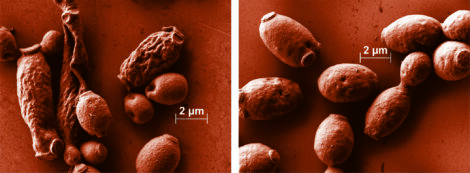Develop an understanding of microbial and fungal metabolism necessary to design new strains, communities, or enzymes capable of converting plant biomass components into fuels, chemicals, and bioproducts.

Developing Robust Microbes. In breaking down plant cell walls, chemicals such as ionic liquids (ILs) are used, but ILs often keep microbes from growing. Scientists have learned how one strain of yeast, Yarrowia lipolytica, strengthens its membranes, enabling it to hold up better to ILs. These scanning electron micrograph images show (left) wild and (right) laboratory-evolved Y. lipolytica grown in a high IL concentration. The evolved strain’s outer membrane displays much less disruption. These insights are important for developing robust microbes that can directly convert plant biomass treated with ILs into biofuels and biochemicals. [Courtesy University of Tennessee]
The Genomic Science Program’s (GSP) research portfolio therefore targets a broad range of challenges affecting all points of the value chain for lignocellulose conversion, including biological solutions for biomass pretreatment and breakdown, conversion of biomass to fuels, and the development of other high-value chemicals and products. Insights gained from this research are also applicable to the breakdown, conversion, and reuse of other manufactured products, such as plastics and other polymers.
These research efforts span the breadth of the GSP portfolio and include work at the bioenergy research centers, DOE national laboratories, and academic laboratories. GSP emphasizes the deployment of genomic biology tools in the development of metabolic pathways, strains, or microbial consortia to achieve novel chemistries, reduce physiological barriers, and develop innovations that enhance the economic viability of biomass conversion. In addition, the emerging tools of synthetic biology, such as genome editing and de novo DNA synthesis, provide unprecedented opportunities for engineering both model and nonmodel organisms to achieve GSP’s mission.
Objectives for microbial conversion research are to:
- Discover and develop new microorganisms with unusual or enhanced capabilities for converting plant biomass to next-generation biofuels, bioproducts, or biomaterials.
- Identify and characterize novel molecular structures, functional capabilities, and biosynthetic pathways that may help to increase the yield and/or synthesis of advanced biofuels, bioproducts, and biomaterials.
- Uncover the functional relationships within microbiomes and defined consortia that harbor the potential to produce biofuels, bioproducts, or biomaterials.
- Identify mechanisms for enhanced strain tolerance to physicochemical stresses associated with industrial-scale production (e.g., elevated temperature, altered pH levels, product toxicity, and toxin release).
- Develop the necessary high-throughput omics-based tools to design, build, and test microbial solutions and enhance their biofuel, bioproduct, and biomaterial production properties.
